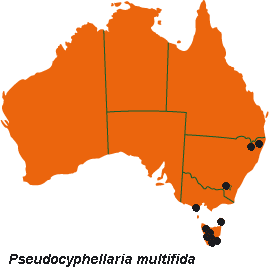



Australian Biological Resources Study
| Checklist of the Lichens of Australia and its Island Territories | ||
| Introduction | A–D | E–O | P–R | S–Z | Oceanic Islands | References | ||
| Pseudocyphellaria multifida (Nyl.) D.J.Galloway & P.James | ||
| Lichenologist 12: 301 (1980); Sticta multifida Nyl., Syn. Meth. Lich. 1(2): 363 (1860); Sticta dissecta aurer, Linnaea 2: 41 (1827) non S. dissecta (Sw.) Ach., Methodus 279 (1803). T: New Holland [Australia], F.Sieber 45; lecto: BM, fide D.J.Galloway, Bull. Brit. Mus. (Nat. Hist.), Bot. 17: 199 (1988); isolecto: BM, G, L, PC-LENORMAND, PC-THURET. | ||
| Thallus irregularly spreading, loosely attached, 2–10 (–15) cm wide. Lobes narrow, 0.5–3 (–5) cm long, 1–5 (–10) mm wide, complexly branched, entangled-imbricate, ±discrete at margins; lobe margins entire, ragged, incised, richly phyllidiate, slightly thickened below and occasionally ridged above. Upper surface greenish grey to buff-brown when dry, lettuce-green to dark emerald-green when wet, smooth, undulate, occasionally shallowly wrinkled or pitted, minutely white-papillate (×10 lens), occasionally maculate, without pseudocyphellae or soredia. Phyllidia common, often obscuring thallus, marginal or regenerating from laminal cracks or tears, simple to richly divided, squamiform to strap-like. Medulla white. Photobiont green. Lower surface whitish to pale buff and glabrous at margins, darker centrally with a short white velvety patchily developed tomentum. Pseudocyphellae scattered, white, fleck-like, most noticeable at margins (×10 lens). Apothecia uncommon, sessile, 0.5–4 mm diam.; disc pale to dark red-brown, matt, epruinose; exciple roughened-papillate; epithecium yellow-brown, K+ olive-brown; hymenium colourless; hypothecium hyaline to pale straw-yellow, K–. Ascospores broadly fusiform-ellipsoidal, 1–3-septate, 23–34 × 9–11 µm, pale yellow-brown. CHEMISTRY: 7β-acetocyhopane-22-ol, hopane-7β,22-diol (trace) and hopane-15α,22-diol. |  |
|
| Common in wet forest and alpine heath in eastern N.S.W., southern Vic. and, especially, in Tas. Also in Malesia and New Zealand. | ||
| Galloway et al. (2001) | ||
| Checklist Index |
| Introduction | A–D | E–O | P–R | S–Z | Oceanic Islands | References |
This work is copyright. Apart from any use as permitted under the Copyright Act 1968, no part may be reproduced by any process without prior written permission from Australian Biological Resources Study. Requests and inquiries concerning reproduction and rights should be addressed in the first instance to Dr P. McCarthy. These pages may not be displayed on, or downloaded to, any other server without the express permission of ABRS.